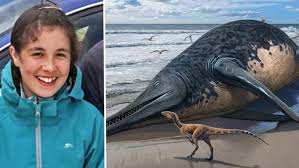A father-daughter team’s accidental fossil-hunting expedition may have yielded the largest marine reptile to have ever graced our oceans, in a stunning turn of events. The amazing discovery, which took years to piece together, is from a new species of ichthyosaur, a marine predator that existed in the prehistoric age and was comparable in size to a blue whale.
In Somerset, England’s Lilstock Beach, the story starts in 2016. The first clue to the mystery was discovered by fossil collector Paul de la Salle when he came upon a massive jawbone fragment. Dean Lomax, a paleontologist at the University of Manchester, led a multiyear scientific project that was inspired by this original discovery. The significant turning point, however, was discovered in 2020 when 11-year-old Ruby Reynolds and her father Justin discovered another piece of the same jawbone while out fossil hunting on Blue Anchor Beach.
The Reynoldses’ apparently routine beach outing sparked an investigation by scientists. The paleontological search was rekindled by Ruby’s discovery, which was a perfect match for the earlier portion discovered. Ruby set out on a methodical search for the final pieces of this ancient jigsaw puzzle over the course of the following two years, working with her father and Dr. Lomax’s team. After that, each piece that was carefully gathered from the shore in Somerset painted a fuller picture of the enormous animal. The team’s incredible discovery was confirmed when they eventually located the final fragment in October 2022.
The entire jawbone’s analysis, which was just published in the journal PLOS ONE, depicts a massive creature. This new species of ichthyosaur dwarfs even the largest known sea reptile, with an estimated length of about 25 meters (82 ft). The amazing species has been given the name Ichthyotitan severnensis by Dr. Lomax and his team. This name means “giant fish lizard of the Severn,” a reference to the River Severn that empties into the Bristol Channel, where the fossils were discovered.
Understanding prehistoric marine life has greatly benefited from the discovery of Ichthyotitan severnensis. Known by the common nickname “fish-lizards,” ichthyosaurs were a varied order of marine reptiles that ruled the oceans from 252 and 66 million years ago. Ichthyosaurs, despite their outward fish-like appearance, were essentially air-breathing reptiles with powerful tails and streamlined bodies for effective swimming.
Dating from the Rhaetian Age approximately 202 million years ago, Ichthyotitan severnensis represents the last phase of the ichthyosaur dynasty. During this time, a large amount of marine life was wiped off during a mass extinction event. Understanding the ecology and dynamics of the late Triassic oceans is made possible by the discovery of such a massive predator existing just prior to this extinction event.
The discovery of Ichthyotitan severnensis is a story that celebrates curiosity and teamwork, rather than merely being a scientific discovery. A little girl’s coincidental encounter on a beach excursion initiated a scientific investigation that resulted in a revolutionary discovery. This exciting discovery emphasizes the value of citizen science and public involvement in paleontology.
This is not the end of the narrative. Scientists will learn a great deal about the anatomy, eating habits, and place of Ichthyotitan severnensis in the ichthyosaur family tree by further examination of the remains. Offering a window into the fascinating world of these long-lost titans of the deep, this discovery is sure to pique the interest of paleontologists and fans alike and inspire more investigation.




